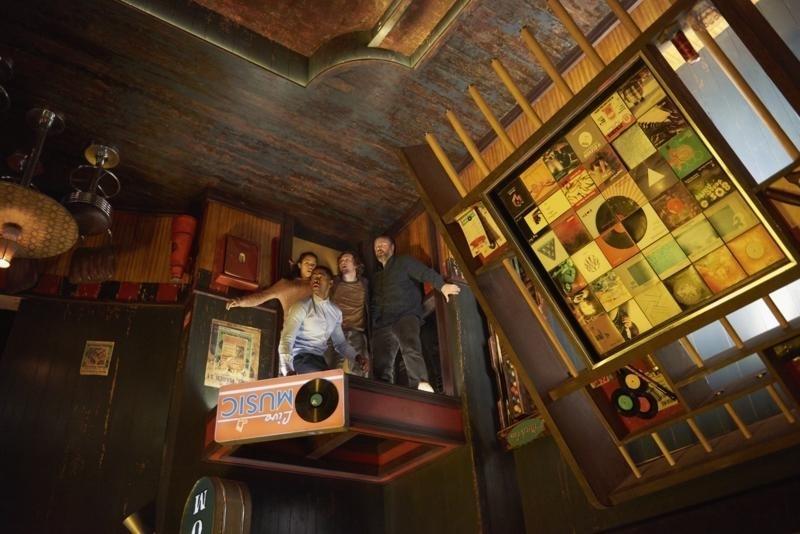REVIEW: ‘Escape Room’ solves the puzzle with fun thrills

In one of the film’s best sequences, a retro sports bar is turned on its head as Zoey (Taylor Russel) accompanies a group of strangers through the building’s deadly traps.
 The recent trend of turning other forms of entertainment into feature-length films has proven to be a largely unsuccessful venture (see: “Battleship,” “The Angry Birds Movie,” etc.) While “Escape Room” isn’t great, it also isn’t the uninspired drivel that “The Emoji Movie” is.
The recent trend of turning other forms of entertainment into feature-length films has proven to be a largely unsuccessful venture (see: “Battleship,” “The Angry Birds Movie,” etc.) While “Escape Room” isn’t great, it also isn’t the uninspired drivel that “The Emoji Movie” is.
From director Adam Robitel, who graduated from USC’s School of Cinematic Arts in 2001, the film follows six strangers who each receive an invitation to participate in an escape room for a $10,000 prize. Of course, upon arrival, they quickly realize that the fun game they were about to play is actually a death trap complete with puzzles they must solve to escape.
Each room the group encounters contains a creative set piece. The first is a waiting room-turned-oven that starts cooking its occupants alive, quickly followed by a tundra landscape in which the characters must avoid freezing to death.
The standout room is an upside-down pool bar, where, as time progresses, parts of the floor (ceiling) drop out. The camera flips and rotates often in a set that’s filled with bright colors and retro set pieces, confusing viewers as much as the room confuses the characters.
The pool bar scene also lends itself to some of the film’s best acting performances. Deborah Ann Woll, who plays a war veteran suffering from PTSD, stands out in particular. Her emotional dexterity throughout the scene brings life to her character, and she becomes a natural leader as she directs the others.
The other actors in the film include Taylor Russell, a shy college student who becomes the obvious final girl; Tyler Labine, a cheery truck driver; Jay Ellis, an arrogant investment banker; Nik Dodani, a cliche gaming nerd and Logan Miller, a lonely grocery store stock boy.
Each puzzle is designed around each character’s personal traumas, which eventually reveal the underlying connection between the seemingly random acquaintances. But because the puzzles require knowledge the audience lacks, viewers aren’t able to follow along with the escape room challenges themselves, which feels like a missed opportunity for an otherwise compelling concept. If Netflix makes another interactive film like “Bandersnatch,” an “Escape Room”-style movie where the viewer helps solve the puzzle feels like a natural fit.
The film draws almost all of its plot from the “Saw” franchise — like the Jigsaw Killer, the ostensible villain in “Escape Room” designs each puzzle to kill. This comparison is no more obvious than in the movie’s poster, which shows Russel with puzzle pieces missing from her skin. Likewise, Jigsaw’s trademark move was to cut a puzzle piece-shaped chunk out of his victims’ faces after he killed them. It isn’t so much a rip-off as it does draw inspiration, however, each puzzle is unique to the film and doesn’t merely imitate Jigsaw’s antics.
The PG-13 movie also ditches the gore and fear of “Saw” and other horror films, and it barely qualifies as a horror film due to the lack of, well, horror. Viewers know exactly how a character will die as soon as the film reveals each room’s conceit — the film’s true thrill comes from the suspense of trying to solve the puzzle before time runs out.
Still, that suspense is thrilling. The potential monotony of following six characters makes it hard to have much dimension at all, but the viewer cares just enough to root for them to make it to the next puzzle.
Toward the end of the film, the audience learns who’s behind the deadly escape rooms, and it is a largely unsatisfying reveal. The monologue that serves as the reveal’s exposition makes it feel like screenwriters Bragi Schut and Maria Melnik were just looking for an easy reason that the clever conceit of the rest of the film exists at all.
The ending also spends about 15 minutes (15 minutes too many) very obviously setting up a sequel — it’s a disappointing cap on an otherwise entertaining experience. Still, if “Escape Room” receives a sequel, the franchise has much to build on and improve. While the film’s visuals are stunning and the rooms are creative, the film could benefit from puzzles and storylines that challenge the audience as much as they do the characters.
